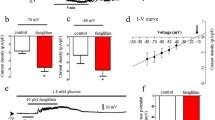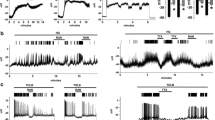Abstract
The aim of the present study was to evaluate whether HIV protease inhibitors directly interfere with stimulus-secretion coupling in pancreatic β-cells. Insulin secretion was determined by a radioimmunoassay (RIA), cytosolic free Ca2+ concentration ([Ca2+]c) with the fluorescence dye fura-2 and whole-cell membrane currents with the patch-clamp technique.
Glucose-induced insulin secretion was inhibited in a concentration-dependent manner by ritonavir and nelfinavir but not by indinavir. Ritonavir and nelfinavir lowered [Ca2+]c in the presence of a stimulatory glucose concentration whereas indinavir again had no effect. Ritonavir and nelfinavir completely inhibited the effect of tolbutamide, which normally increases [Ca2+]c by blocking KATP channels. This observation points to an action of both drugs on KATP channels or a step distal to these channels in stimulus-secretion coupling. Ritonavir was used to further evaluate the direct effects of HIV protease inhibitors on β-cell ion channel currents. Unexpectedly, ritonavir inhibited neither the whole-cell KATP current nor the whole-cell L-type Ca2+ current. Tolbutamide almost completely suppressed the KATP current in the presence of ritonavir excluding that ritonavir alters the tolbutamide sensitivity of the KATP channel. Ritonavir increased the length and decreased the frequency of glucose-induced action potentials. This effect can be attributed to inhibition of voltage-dependent K+ currents. Intracellular stores seem not to be involved in the ritonavir-induced lowering of [Ca2+]c.
In conclusion, different HIV protease inhibitors surprisingly reveal distinct effects on insulin secretion. Ritonavir inhibits insulin secretion by lowering [Ca2+]c but this effect is evidently independent of the opening of KATP channels or the closure of voltage-dependent Ca2+ channels, which are commonly considered to play a key role in stimulus-secretion coupling.








Similar content being viewed by others
Abbreviations
- [Ca2+]c :
-
Cytosolic Ca2+ concentration
- RIA:
-
Radioimmunoassay
References
Anderson PL, Brundage RC, Bushman L, Kakuda TN, Remmel RP, Fletcher CV (2000) Indinavir plasma protein binding in HIV-1-infected adults. AIDS 14:2293–2297
Ashcroft FM, Rorsman P (1989) Electrophysiology of the pancreatic β-cell. Prog Biophys Mol Biol 54:87–143
Baede-van Dijk PA, Hugen PW, Verweij-van Wissen CP, Koopmans PP, Burger DM, Hekster YA (2001) Analysis of variation in plasma concentrations of nelfinavir and its active metabolite M8 in HIV-positive patients. AIDS 15:1057–1058
Behrens G, Dejam A, Schmidt H, Balks HJ, Brabant G, Korner T, Stoll M, Schmidt RE (1999) Impaired glucose tolerance, beta cell function and lipid metabolism in HIV patients under treatment with protease inhibitors. AIDS 13:F63–F70
Chen D, Misra A, Garg A (2002) Lipodystrophy in human immunodeficiency virus-infected patients. J Clin Endocrinol Metab 87:4845–4856
Clement B (2001) HIV-Protease-Inhibitoren: state of the art. Pharmazie in unserer Zeit 30:208–211
Denissen JF, Grabowski BA, Johnson MK, Buko AM, Kempf DJ, Thomas SB, Surber BW (1997) Metabolism and disposition of the HIV-1 protease inhibitor ritonavir (ABT-538) in rats, dogs, and humans. Drug Metab Dispos 25:489–501
Dowell P, Flexner C, Kwiterovich PO, Lane MD (2000) Suppression of preadipocyte differentiation and promotion of adipocyte death by HIV protease inhibitors. J Biol Chem 275:41325–41332
Gatti G, Di Biagio A, Casazza R, De Pascalis C, Bassetti M, Cruciani M, Vella S, Bassetti D (1999) The relationship between ritonavir plasma levels and side-effects: implications for therapeutic drug monitoring. AIDS 13:2083–2089
Germinario RJ, Colby-Germinario SP, Cammalleri C, Wainberg MA (2003) The long-term effects of anti-retroviral protease inhibitors on sugar transport in L6 cells. J Endocrinol 178:449–456
Grapengiesser E, Gylfe E, Hellman B (1988) Dual effect of glucose on cytoplasmic Ca2+ in single pancreatic β-cells. Biochem Biophys Res Commun 150:419–425
Grynkiewicz G, Poenie M, Tsien RY (1985) A new generation of Ca2+ indicators with greatly improved fluorescence properties. J Biol Chem 260:3440–3450
Henquin JC (1990) Role of voltage- and Ca2+-dependent K+ channels in the control of glucose-induced electrical activity in pancreatic B-cells. Pflügers Arch Eur J Physiol 416:568–572
Hruz PW, Murata H, Qiu H, Mueckler M (2002) Indinavir induces acute and reversible peripheral insulin resistance in rats. Diabetes 51:937–942
Koster JC, Remedi MS, Qiu H, Nichols CG, Hruz PW (2003) HIV protease inhibitors acutely impair glucose-stimulated insulin release. Diabetes 52:1695–1700
Lee EC, Walmsley S, Fantus IG (1999) New-onset diabetes mellitus associated with protease inhibitor therapy in an HIV-positive patient. CMAJ 161:161–164
MacDonald PE, Wheeler, MB (2003) Voltage-dependent K+ channels in pancreatic beta cells: role, regulation and potential as therapeutic targets. Diabetologia 46:1046–1062
MacDonald PE, Ha XF, Wang J, Smukler SR, Sun AM, Gaisano HY, Salapatek AM, Backx PH, Wheeler MB (2001) Members of the Kv1 and Kv2 voltage-dependent K(+) channel families regulate insulin secretion. Mol Endocrinol 15:1423–1435
MacDonald PE, Sewing S, Wang J, Joseph JW, Smukler SR, Sakellaropoulod G, Wang J, Saleh MC, Chan CB, Tsushima RG, Salapatek RG, Wheeler MB (2002) Inhibition of Kv2.1 voltage-dependent K+ channels in pancreatic beta-cells enhances glucose-dependent insulin secretion. J Biol Chem 277:44938–44945
Murata H, Hruz PW, Mueckler M (2000) The mechanism of insulin resistance caused by HIV protease inhibitor therapy. J Biol Chem 275:20251–20254
Nolte LA, Yarasheski KE, Kawanaka K, Fisher J, Le N, Holloszy JO (2001) The HIV protease inhibitor indinavir decreases insulin- and contraction-stimulated glucose transport in skeletal muscle. Diabetes 50:1397–1401
Noor MA, Lo JC, Mulligan K, Schwarz JM, Halvorsen RA, Schambelan M, Grunfeld C (2001) Metabolic effects of indinavir in healthy HIV-seronegative men. AIDS 15:F11–F18
Noor MA, Seneviratne T, Aweeka FT, Lo JC, Schwarz JM, Mulligan K, Schambelan M, Grunfeld C (2002) Indinavir acutely inhibits insulin-stimulated glucose disposal in humans: a randomized, placebo-controlled study. AIDS 16:F1–F8
Plant TD (1988) Properties and calcium-dependent inactivation of calcium currents in cultured mouse pancreatic B-cells. J Physiol 404:731–747
Roe MW, Worley JF, Mittal AA, Kuznetsov A, DasGupta S, Mertz RJ, Witherspoon SM, Blair N, Lancaster ME, McIntyre MS, Shehee WR, Dukes ID, Philipson LH (1996) Expression and function of pancreatic beta-cell delayed rectifier K+ channels. Role in stimulus-secretion coupling. J Biol Chem 271:32241–32246
Rudich A, Konrad D, Torok, D, Ben-Romano R, Huang C, Niu W, Garg RR, Wijesekara N, Germinario RJ, Bilan PJ, Klip A (2003) Indinavir uncovers different contributions of GLUT4 and GLUT1 towards glucose uptake in muscle and fat cells and tissues. Diabetologia 46:649–658
Schutt M, Meier M, Meyer M, Klein J, Aries SP, Klein HH (2000) The HIV-1 protease inhibitor indinavir impairs insulin signalling in HepG2 hepatoma cells. Diabetologia 43:1145–1148
Shetty BV, Kosa MB, Khalil DA, Webber S (1996) Preclinical pharmacokinetics and distribution to tissue of AG1343, an inhibitor of human immunodeficiency virus type 1 protease. Antimicrob Agents Chemother 40:110–114
Su J, Yu H, Lenka N, Hescheler J, Ullrich S (2001) The expression and regulation of depolarization-activated K+ channels in the insulin-secreting cell line INS-1. Pflügers Arch Eur J Physiol 442:49–56
Trube G, Rorsman P, Ohno-Shosaku T (1986) Opposite effects of tolbutamide and diazoxide on ATP-dependent K+ channel in mouse pancreatic beta-cells. Pflügers Arch-Eur J Physiol 407:493–499
Tsiodras S, Mantzoros C, Hammer S, Samore M (2000) Effects of protease inhibitors on hyperglycemia, hyperlipidemia, and lipodystrophy: a 5-year cohort study. Arch Intern Med 160:2050–2056
Woerle HJ, Mariuz PR, Meyer C, Reichman RC, Popa EM, Dostou JM, Welle SL, Gerich JE (2003) Mechanisms for the deterioration in glucose tolerance associated with HIV protease inhibitor regimes. Diabetes 52:918–925
Yarasheski KE, Tebas P, Sigmund C, Dagogo-Jack S, Bohrer A, Turk J, Halban PA, Cryer PE, Powderly WG (1999) Insulin resistance in HIV protease inhibitor-associated diabetes. J Acquir Immune Defic Syndr 21:209–216
Zhou Z, Misler S (1996) Amperometric detection of quantal secretion from patch-clamped rat pancreatic beta-cell. J Biol Chem 271:270–277
Acknowledgements
We gratefully acknowledge the purification of nelfinavir and indinavir by Professor Dr. Laufer and colleagues (Tübingen, Germany) and the technical assistance of Mrs. Isolde Breuning. This work was supported by grants of the Deutsche Forschungsgemeinschaft (Dr 225/6–1) and of the Deutsche Diabetes-Stiftung.
Author information
Authors and Affiliations
Corresponding author
Rights and permissions
About this article
Cite this article
Düfer, M., Neye, Y., Krippeit-Drews, P. et al. Direct interference of HIV protease inhibitors with pancreatic β-cell function. Naunyn-Schmiedeberg's Arch Pharmacol 369, 583–590 (2004). https://doi.org/10.1007/s00210-004-0933-6
Received:
Accepted:
Published:
Issue Date:
DOI: https://doi.org/10.1007/s00210-004-0933-6




